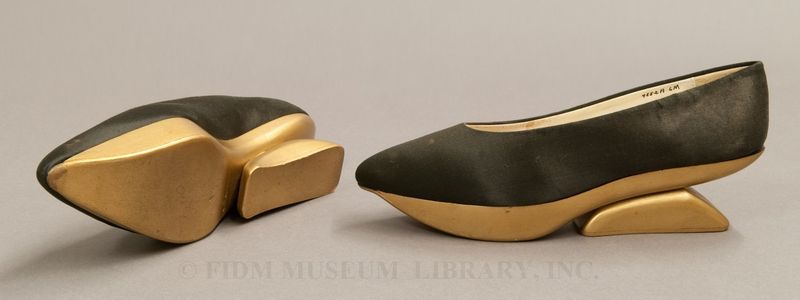Beth Levine's Kabuki shoes
Self-taught shoe designer Beth Levine (1914-2006) created some of the most innovative and fanciful shoes of the 20th century. Levine began her career in 1938 as a shoe model/secretary for a New York shoe manufacturer. Given that Beth had size 4 feet, it was almost as if she were born for the job! Levine soon realized that she had more than a passing interest in shoes. Regarding her experiences in her first position, Levine later said, "I could tell anything from the inside of the shoe. I could even tell by the feel of the shoe how it had been manufactured."1 After working at a series of shoe manufacturers, Levine interviewed for a design position at Andrew Geller, an upscale New York shoe manufacturer in 1946. Her interviewer, Herbert Levine, became her husband a few months later. After their marriage, the Levines decided to open a shoe manufacturer with the goal of creating beautiful, inventive, carefully constructed shoes, using an assembly line process. Under the company name "Herbert Levine," they shipped their first shoes in 1949. Though Herbert's name was on the shoe box, Beth was the true creative force behind the team. Within a few years, Levine shoes were sold throughout North America and Europe. They were also widely copied, always a true sign of admiration.
 Kabuki shoes Beth Levine c. 1964 Silk satin uppers, wood soles Museum Purchase 2005.5.173AB
Kabuki shoes Beth Levine c. 1964 Silk satin uppers, wood soles Museum Purchase 2005.5.173AB
Given the diversity of her creations, it's difficult to pinpoint a particular shoe as being the embodiment of Beth Levine's aesthetic. Levine created elegant evening shoes of silk and sequins, whimsical boots of printed textiles, paper shoes and the unforgettable Astroturf sandal, with a footbed of bright green Astroturf. What is shared among Levine's creations is her boundless interest in experimenting with both form and material. Beth Levine first designed the Kabuki shoe in 1959, a few years after the Levines traveled to Asia and the Middle East. The unusual sole was intended to evoke geta, the wooden, clog-like shoes worn by Japanese kabuki performers. The forward tilt of the shoe, along with the floating heel, convey an impression of lightness. Levine thought that the shape of the sole made the shoe itself appear to float. Levine created many variations of the Kabuki, often in black/white or black/gold color combinations.
If you have seen other examples of the Kabuki shoe, you'll notice that the sole of the FIDM Museum version is slightly different. The attached portion of the sole is shorter and does not extend the full length of the shoe. In other versions, the attached sole is longer and thinner. To see a pair of black patent leather Kabuki shoes with this sole, click here. The FIDM Museum Kabuki shoes retailed at Sak's Fifth Avenue. The retailer may have requested a sole modification to distinguish "their" Kabuki shoes from those retailed elsewhere. Readers, if you're interested in Beth Levine's work, you might need to make a trip to Washington State! Beth Levine: First Lady of Shoes is on display at the Bellevue Arts Museum in Bellevue, Washington until June 6, 2010. If you have visited (or plan to visit) this exhibition, let us know!
1 Quoted in Verin, Helene. Beth Levine Shoes. New York: Stewart, Tabori & Chang, 2009.: 18.